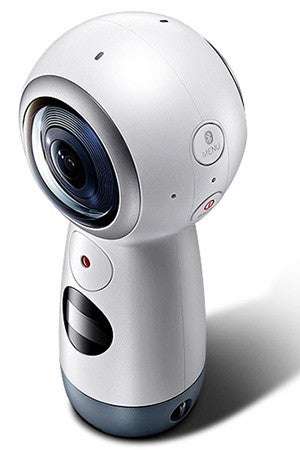
Samsung Gear 360 (2017) Review: An Accessible Entry into 360-Degree Content Creation
The Samsung Gear 360 (2017) promised to bring accessible 360-degree content creation to the masses, offering a simplified and more user-friendly experience compared to its predecessor. Stepping away from the original’s bulky, almost alien design, the 2017 model opted for a more streamlined and easily portable form factor. This shift aimed to make capturing immersive videos and photos a seamless part of everyday life, appealing to casual users and aspiring content creators alike. But does this focus on accessibility come at the expense of image quality or advanced features? This review will delve deep into the capabilities of the Samsung Gear 360 (2017), exploring its strengths, weaknesses, and overall value proposition for today’s content creator.
Design and Usability
The redesigned form factor is immediately noticeable. Gone is the awkward orb, replaced by a more elongated, almost microphone-like design. This makes the Samsung Gear 360 (2017) far easier to hold and carry. A small tripod is included, which is essential for stable shooting. However, the plastic construction feels a little less premium than the original, which is a trade-off for the lower price point.
Key Design Features:
- Compact and lightweight design
- Easy to hold and carry
- Included tripod for stable shooting
- MicroSD card slot for storage expansion
Image and Video Quality
The Gear 360 (2017) boasts dual 8.4-megapixel sensors, capable of capturing 360-degree videos in 4K resolution (3840 x 1920). While the resolution is impressive on paper, the actual image quality can be somewhat disappointing, particularly in less-than-ideal lighting conditions. Images tend to appear soft and lack detail, especially when viewed in VR. Video quality suffers from similar issues, with noticeable noise and a lack of sharpness. Stitching, the process of combining the images from the two lenses, is generally well-done, but occasional artifacts can be visible. The biggest hurdle for the device is that the picture captured is less sharp than some modern smartphones.
Software and Connectivity
The Gear 360 (2017) connects to smartphones via Wi-Fi Direct and Bluetooth. The companion app, available for both Android and iOS, allows for remote control, live streaming, and easy sharing of content. The app is relatively user-friendly, but can sometimes be a bit buggy. One positive is the ability to livestream directly to social media platforms such as Facebook and YouTube. This makes it easy to share your 360-degree experiences with the world.
Comparison
| Feature | Samsung Gear 360 (2017) | Original Samsung Gear 360 |
|---|---|---|
| Design | Streamlined, microphone-like | Bulky orb |
| Resolution | 4K (3840 x 1920) | 4K (3840 x 1920) |
| Price | Lower | Higher |
| Portability | More portable | Less portable |
Final Verdict
Overall, the **Samsung Gear 360 (2017)** offers an accessible entry point into the world of 360-degree content creation. Its compact design, ease of use, and live streaming capabilities make it an appealing option for casual users. While image and video quality may not be top-of-the-line, the device is still capable of capturing shareable 360-degree content. It’s a decent entry level 360 camera that is simple to operate. However, if you’re looking for professional-grade results, you may want to consider more expensive options.
The Gear 360 (2017)’s biggest strength lies in its simplicity. The intuitive interface and straightforward controls allow even novice users to quickly grasp the basics of 360-degree photography and videography. The live streaming feature is a significant advantage, enabling real-time sharing of immersive experiences with friends and followers. However, the image quality limitations are a real drawback, especially when compared to the increasingly capable cameras found in modern smartphones.
ALTERNATIVES TO CONSIDER
Before making a purchase, it’s worth exploring alternative options. The Ricoh Theta series offers a range of 360-degree cameras with varying price points and features. These cameras often excel in image quality and offer more advanced controls. Another contender is the Insta360 line, known for its innovative designs and unique shooting modes. Ultimately, the best choice depends on your individual needs and budget.
KEY CONSIDERATIONS WHEN CHOOSING A 360 CAMERA:
– Image Quality: Resolution, sensor size, and lens quality all contribute to the final image.
– Ease of Use: Consider the interface, controls, and companion app.
– Features: Look for features like live streaming, stabilization, and advanced shooting modes.
– Price: 360 cameras range in price from budget-friendly to professional-grade.
TIPS FOR USING THE SAMSUNG GEAR 360 (2017)
To get the most out of your Gear 360 (2017), here are a few tips:
– Shoot in good lighting: This will significantly improve image quality.
– Use a tripod: This is essential for stable shooting, especially in low light.
– Experiment with different shooting modes: Explore the various options available in the companion app.
– Practice your stitching: Learn how to manually adjust stitching if necessary.
– Consider post-processing: Editing software can help improve image quality and remove artifacts.
In conclusion, while not perfect, the Samsung Gear 360 (2017) remains a viable option for those seeking an easy and affordable way to capture 360-degree content; Its user-friendly design and live streaming capabilities make it a compelling choice for casual users.



